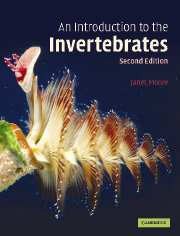Book contents
- Frontmatter
- Contents
- List of boxes
- Preface
- Acknowledgements
- Illustration acknowledgements
- Chapter 1 The process of evolution: natural selection
- Chapter 2 The pattern of evolution: methods of investigation
- Chapter 3 Porifera
- Chapter 4 Cnidaria
- Chapter 5 On being a worm
- Chapter 6 Platyhelminthes and Acoelomorpha
- Chapter 7 Nemertea
- Chapter 8 Nematoda
- Chapter 9 Annelida
- Chapter 10 Mollusca: general and Gastropoda
- Chapter 11 Mollusca: Bivalvia and Cephalopoda
- Chapter 12 Arthropoda: general
- Chapter 13 Crustacea
- Chapter 14 Chelicerata and Myriapoda
- Chapter 15 Insecta
- Chapter 16 Animals with lophophores
- Chapter 17 Echinodermata
- Chapter 18 Invertebrate Chordata and Hemichordata
- Chapter 19 Development
- Chapter 20 Invertebrate evolutionary history
- Further reading
- Glossary
- Index
Chapter 5 - On being a worm
Published online by Cambridge University Press: 05 September 2012
- Frontmatter
- Contents
- List of boxes
- Preface
- Acknowledgements
- Illustration acknowledgements
- Chapter 1 The process of evolution: natural selection
- Chapter 2 The pattern of evolution: methods of investigation
- Chapter 3 Porifera
- Chapter 4 Cnidaria
- Chapter 5 On being a worm
- Chapter 6 Platyhelminthes and Acoelomorpha
- Chapter 7 Nemertea
- Chapter 8 Nematoda
- Chapter 9 Annelida
- Chapter 10 Mollusca: general and Gastropoda
- Chapter 11 Mollusca: Bivalvia and Cephalopoda
- Chapter 12 Arthropoda: general
- Chapter 13 Crustacea
- Chapter 14 Chelicerata and Myriapoda
- Chapter 15 Insecta
- Chapter 16 Animals with lophophores
- Chapter 17 Echinodermata
- Chapter 18 Invertebrate Chordata and Hemichordata
- Chapter 19 Development
- Chapter 20 Invertebrate evolutionary history
- Further reading
- Glossary
- Index
Summary
Any soft-bodied legless animal whose length exceeds its width is liable to be described as a worm, and many invertebrates fit this description. Four of the main worm-like phyla are discussed separately in later chapters, but there are many other different worms, belonging to phyla often castigated as ‘minor’, usually because they have a small number of species or are very small animals. This chapter introduces the variety of worms, after considering why worms should have evolved so many times and what muscular machinery is necessary for their locomotion.
Why are there so many different kinds of worm?
Mechanical facts about the molecules that make up animals mean that worms are very easily produced. Cells secrete extracellular compounds with charged molecular backbones: like charges repel, causing linear extension, and linkage between these large molecules provides orientation in a structure that will be anisotropic (i.e. have different properties in different directions). If a blob of soft tissue has such orientated fibres, any event such as growth or motion or external pressure will automatically turn that blob into a cylinder. Orientated fibres will guide and limit the direction of growth, and enable it to change its shape. No further genetic instruction is needed to make a worm, in its simplest form.
Information
- Type
- Chapter
- Information
- An Introduction to the Invertebrates , pp. 47 - 64Publisher: Cambridge University PressPrint publication year: 2006
